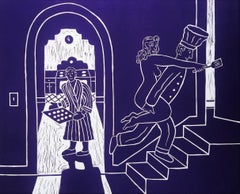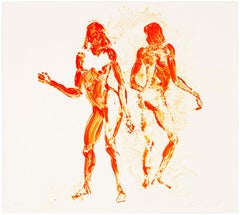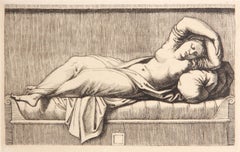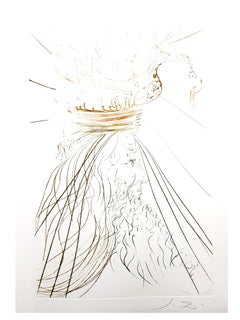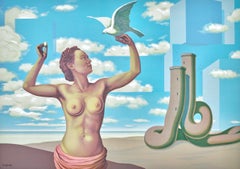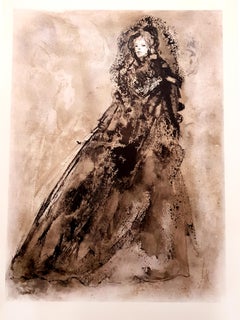Unframed Nude Prints
to
202
910
370
464
101
87
Overall Width
to
Overall Height
to
536
495
207
151
57
56
37
17
16
10
6
6
1
82
56
51
47
31
14
46
1,490
382
14
61
90
96
41
97
171
408
214
87
12
1,277
615
34
1,434
895
702
554
352
330
322
295
203
68
57
48
42
39
37
36
34
32
26
25
716
572
289
163
109
280
693
932
869
Frame Included
Up the Stairs (Blue) /// Contemporary Funny Romantic Linocut Humour Art
By Dan May
Located in Saint Augustine, FL
Artist: Dan May (American, 1955-)
Title: "Up the Stairs (Blue)"
*Signed and numbered by May in pencil lower left
Year: 1998
Medium: Original Linocut on white Hosho handmade paper
Lim...
Category
1990s Contemporary Nude Prints
Materials
Linocut
Eric Fischl, , Two Girls Dancing
By Eric Fischl
Located in New York, NY
TWO GIRLS DANCING
Year: 2011
Medium: 2-color lithograph
Size: 27 x 30 inches (69 x 76 cm)
Edition: 100
Price: $1,900
Born in New York City in 1948, Eric Fischl grew up in the suburbs of Long Island , his parents having moved there shortly before his second year.”Safer place to raise a family”, they used to say. Against a backdrop of alcoholism and a country club culture obsessed with image over content, Fischl became focused on the rift between what was experienced and what could not be said. Until the late 70’s, suburbia was not considered a legitimate genre for art. With his first New York show at the Edward Thorp Gallery, epithets like “psycho-sexual suburban dramas” became velcroed to his disturbing images of dyfunctional family life.
Fischl began his art education in Phoenix, Arizona where his parents had moved in 1967. First at Phoenix Junior College, then a year at Arizona State University, and finally getting his BFA in 1972 at the recently opened California Institute of the Arts in Valencia, California. After graduation he moved to Chicago where he worked as a guard at the Museum of Contemporary Art. It was in Chicago that Fischl was exposed to the non-mainstream art of the Hairy Who. “The underbelly, carnie world of Ed Paschke and the hilarious sexual vulgarity of Jim Nutt...
Category
2010s Contemporary Figurative Prints
Materials
Lithograph
Cleopatre, Old Masters Heliogravure Etching by Marcantonio Raimondi
Located in Long Island City, NY
Marcantonio Raimondi, After by Amand Durand, Italian (1480 - 1534) - Cleopatre, Year: 1875, Medium: Heliogravure, Size: 4.75 x 7 in. (12.07 x 17.78 cm), Printer: Amand Durand, Des...
Category
1870s Old Masters Nude Prints
Materials
Etching
Salvador Dali - King Marc
Located in Collonge Bellerive, Geneve, CH
Salvador Dali - King Marc - Original Etching
Dimensions: 45 x 33 cm
Edition: 125
1970
Signed in pencil.
On Arches Vellum
References : Field 70-10 (p. 60-61)
Category
1970s Surrealist Nude Prints
Materials
Etching
Rene Magritte, A Young Woman Presents with Grace, 1968 (after)
Located in Southampton, NY
This exquisite lithograph after Rene Magritte (1898–1967), titled Une Jeune Femme Presente avec Grace (A Young Woman Presents with Grace), from the folio Les Enfants Trouves de Magritte (The Found Children of Magritte), 1968, originates from the edition published by A.C. Mazo et Cie, Paris, and printed by Mourlot Freres, Paris, on November 20, 1968. The work embodies Magrittes sustained inquiry into semiotics and visual epistemology, translating his characteristic strategies of displacement, symbolic inversion, and conceptual ambiguity into an image that operates as both a poetic metaphor and a philosophical proposition concerning the instability of meaning.
Executed as a lithograph on grand velin dArches paper, this work measures 17.5 x 23.5 inches (44.5 x 59.7 cm). Signed in the plate by the artist; hand signed by Fernand Mourlot, Editeur. The edition exemplifies the technical mastery of the Mourlot atelier.
Artwork Details:
Artist: After Rene Magritte (1898–1967)
Title: Une Jeune Femme Presente avec Grace (A Young Woman Presents with Grace), from the folio Les Enfants Trouves de Magritte (The Found Children of Magritte)
Medium: Lithograph on grand velin dArches paper
Dimensions: 17.5 x 23.5 inches (44.5 x 59.7 cm)
Inscription: Signed in the plate by the artist; hand signed by Fernand Mourlot, Editeur
Date: 1968
Publisher: A.C. Mazo et Cie, Paris
Printer: Mourlot Freres, Paris
Catalogue Raisonne: Magritte, Rene, et al. Rene Magritte: Catalogue Raisonne, Vol. 3. Menil Foundation; Philip Wilson Publishers; Distributed in the USA and Canada by Rizzoli International, 1992, nos. 791–792 and 1056; vol. 5, p. 218, Bibliography entry 68.28.
Condition: Well preserved, consistent with age and medium
Provenance: From the folio Les Enfants Trouves de Magritte, 1968
Notes:
Excerpted from the folio (translated from French), Finished printing in Paris on November 20, 1968, on the presses of Mourlot, for the lithographs. The unpublished text by Louis Scutenaire was composed in Elzevir Casion corps 28 and printed by Fequet et Baudier, typographers. The unpublished compositions numbered from I to IV were specially made by Rene Magritte for this album. The compositions of the Enchanted Domain, are the renderings of the eight paintings of the mural of the Casino de Knokke. They were printed with the benevolent authorization of Mr. Gustave J. Nellens. Justification of the draw, this album was taken from CCCL examples on grand velin dArches numbered from I to CCCL, plus a few examples for collaborators and assistants.
About the Publication:
Les Enfants Trouves de Magritte (The Found Children of Magritte), published in 1968 by A.C. Mazo et Cie, Paris, represents one of the most significant late life print projects devoted to Rene Magrittes work. Conceived as both a literary and visual tribute, the folio pairs texts by the Belgian writer Louis Scutenaire, Magrittes close friend and fellow Surrealist, with lithographic interpretations produced at the Mourlot atelier, the premier lithographic workshop of twentieth century France. The album includes compositions by Magritte alongside lithographic renderings of the celebrated Enchanted Domain mural from the Casino de Knokke, printed with the authorization of Gustave J. Nellens, who commissioned the original mural. Issued in a single edition of CCCL examples on grand velin dArches, the folio stands as a testament to the collaboration between artist, writer, publisher, and master printer, and remains one of the most culturally important Surrealist print albums of the post war era.
About the Artist:
Rene Magritte (1898–1967) was a Belgian Surrealist painter whose visionary, intellectual, and poetic imagery redefined twentieth century art and forever changed how the world perceives reality and illusion. Celebrated for his calm precision and thought provoking juxtapositions of ordinary objects in extraordinary contexts, Magritte used painting as a philosophical tool, transforming the everyday into visual paradoxes that challenged the boundaries between what is seen and what is known. Born in Lessines, Belgium, and trained at the Academie Royale des Beaux Arts in Brussels, he absorbed early influences from Cubism, Futurism, and Symbolism before embracing Surrealism, where he found his true voice. In Paris, he became part of the avant garde circle that included Pablo Picasso, Alexander Calder, Alberto Giacometti, Salvador Dali, Joan Miro, Wassily Kandinsky, Marcel Duchamp, and Man Ray—all artists whose radical ideas helped him forge his distinctive synthesis of logic and mystery. Unlike Dalis dream...
Category
1960s Surrealist Landscape Prints
Materials
Lithograph
$3,996 Sale Price
20% Off
Leonor Fini - Original Lithograph
By Leonor Fini
Located in Collonge Bellerive, Geneve, CH
Leonor Fini - Original Lithograph
The Flowers of Evil
1964
Conditions: excellent
Edition: 500
Dimensions: 46 x 34 cm
Editions: Le Cercle du Livre Précieux, Paris
Unsigned and unumb...
Category
1960s Modern Nude Prints
Materials
Lithograph
Salvador Dali - Nude, Horse and Death
Located in Collonge Bellerive, Geneve, CH
Salvador Dali - Nude, Horse and Death - Original Etching
Dimensions: 38 x 28 cm
Edition: 235
1967
embossed signature
On Arches Vellum
References : Field 67-10 (p. 34-35)
Category
1960s Surrealist Nude Prints
Materials
Etching
Desnudo, by Frank Romero
By Frank Romero
Located in Palm Springs, CA
This silkscreen print by Chicano artist Frank Romero exemplifies his fluid, expressive line work and culturally rooted subject matter. The image portrays a nude female figure with he...
Category
2010s Contemporary Nude Prints
Materials
Screen
The woman and her abstractness - 21st Century, Contemporary Etching
Located in Warsaw, PL
JERZY DMITRUK (born in 1960) He studied at the Academy of Fine Arts at the Faculty of Paintings and Graphics. Dmitruk graduated in 1986 from the atelier of professor Juliusz Joniak a...
Category
21st Century and Contemporary Other Art Style Abstract Prints
Materials
Paper, Etching
The ideal of a spatial figure - 21st Century, Contemporary Etching
Located in Warsaw, PL
JERZY DMITRUK (born in 1960) He studied at the Academy of Fine Arts at the Faculty of Paintings and Graphics. Dmitruk graduated in 1986 from the atelier of professor Juliusz Joniak a...
Category
21st Century and Contemporary Other Art Style Nude Prints
Materials
Paper, Etching
Peek-a-Boo Marilyn 1, Pop Art Print by Mel Ramos
By Mel Ramos
Located in Long Island City, NY
Artist: Mel Ramos (American, b. 1935)
Title: Peek-a-Boo Marilyn 1
Year: 2002
Medium: Lithograph, signed and numbered in pencil
Edition: 199
Size: 31.5 in. x 23 in. (80.01 cm x 58.42 cm)
Category
Early 2000s Pop Art Nude Prints
Materials
Lithograph
Nude - Etching by Carlo Marcantonio - 1970s
Located in Roma, IT
Nude is an etching on paper realized by Carlo Marcantonio.
Hand-signed in the lower right in pencil.
Good conditions.
Edition of 50.
Category
1970s Contemporary Figurative Prints
Materials
Etching
Nude
Located in Edinburgh, GB
Boris Akopian "Drawing"
Category
1970s Nude Prints
Materials
Paper
Silkscreen Surrealist Pop Art Print "Pas De Deux"
Located in Surfside, FL
Print without matte is 19" X 13".
Michael Knigin was born in 1942 in Brooklyn, NY. He attended and graduated from Tyler School of Art, Temple University. He received a Ford Founda...
Category
21st Century and Contemporary 85 New Wave Abstract Prints
Materials
Screen
Monica Nude With Tulips (large hand signed screen print)
Located in Aventura, FL
Screen print On Lenox museum board. Hand signed lower right margin by Tom Wesselmann. Hand numbered HC 8/12 lower right margin (there was also a main the edition of 100). Sheet si...
Category
1980s Pop Art Nude Prints
Materials
Board, Screen
"Splash" Black & White Nude Photography 24.5 x 17.5" in Ed 1/24 by Larsen Sotelo
Located in Culver City, CA
"Splash" Black & White Nude Photography 24.5 x 17.5" in Ed 1/24 by Larsen Sotelo
Not framed. Ships in a tube
Giclee (Archival Ink) print on 310G Platine Fibre Cotton Rag w/satin fin...
Category
21st Century and Contemporary Modern Nude Prints
Materials
Archival Ink, Rag Paper, Giclée
Fall : Woman under a Tree - Original Etching, Handsigned - Numbered / 225
Located in Paris, IDF
Jean Baptiste VALADIE
Fall : Woman under a Tree
Originale Etching
Signed in pencil
Numbered on 225 copies
On vellum 45 x 32 cm (c. 17.7 x 15.5 inches)
excellent condition
Category
Late 20th Century Modern Nude Prints
Materials
Etching
"Untitled (Nr. 3671)" Nude Photography 44" x 36" Edition of 12 by Rowan Daly
By Rowan Daly
Located in Culver City, CA
"Untitled (Nr. 3671)" Nude Photography 44" x 36" Edition of 12 by Rowan Daly
Unframed - ships rolled in a tube
Ben Cope + Rowan Daly Off the Grid
Off the Grid is the culmination...
Category
21st Century and Contemporary Contemporary Nude Prints
Materials
Archival Pigment
Nude Near Pool /// Contemporary Pop Art Screenprint Nude Figurative Swimming
By Dan May
Located in Saint Augustine, FL
Artist: Dan May (American, 1955-)
Title: "Nude Near Pool"
*Signed and numbered by May in pencil lower left
Year: 1989
Medium: Original Screenprint on unbranded white wove paper
Limit...
Category
1980s Contemporary Nude Prints
Materials
Screen
Leonor Fini - Pleasure - Original Lithograph
By Leonor Fini
Located in Collonge Bellerive, Geneve, CH
Leonor Fini - Pleasure - Original Lithograph
The Flowers of Evil
1964
Conditions: excellent
Edition: 500
Dimensions: 46 x 34 cm
Editions: Le Cercle du Livre Précieux, Paris
Unsigne...
Category
1960s Modern Nude Prints
Materials
Lithograph
Homme nu avec femme ivre et jeune flutiste
Located in Fairlawn, OH
Homme nu avec femme ivre et jeune flutiste
Etching, 1955
Signature stamp lower right (see photo)
Annotated in penci lower leftl: "epreuve d'artiste" (see photo)
Inventory number vers...
Category
1950s Modern Nude Prints
Materials
Etching
after Henri Matisse, "Sitting Blue Nude"
Located in Collonge Bellerive, Geneve, CH
Lithograph after Henri Matisse - Sitting Blue Nude
Artist : after Henri MATISSE
Edition of 200
76 x 56 cm
With stamp of the Succession Matisse
References : Artvalue - Succession Ma...
Category
1950s Modern Nude Prints
Materials
Lithograph
"Evolution Of Jump" Photography 30" x 30" inch Ed. of 24 by Rob Woodcox
By Rob Woodcox
Located in Culver City, CA
"Evolution Of Jump" Photography 30" x 30" inch Ed. of 24 by Rob Woodcox
Hahnemuhle Torchon Matte FineArt Paper (archival)
2018
ABOUT Rob Woodcox
Rob Woodcox is a fine art and fa...
Category
21st Century and Contemporary Contemporary Nude Prints
Materials
Archival Paper
original lithograph
Located in Henderson, NV
Medium: original lithograph. Printed on Arjomari paper in 1969 at the Mourlot Freres atelier and published by Editions Richelieu in a limited edition of 2400 for the L'Odyssee portfo...
Category
1960s Nude Prints
Materials
Lithograph
Jean Cocteau - White Book - Original Handcolored Lithograph
By Jean Cocteau
Located in Collonge Bellerive, Geneve, CH
Jean Cocteau
White Book - Autobiography about Cocteau's discovery of his homosexuality. The book was first published anonymously and created a scandal.
Original Handcolored Lithograp...
Category
1930s Modern Nude Prints
Materials
Lithograph
Nude Descending a Staircase, Pop Art Lithograph by Mel Ramos
By Mel Ramos
Located in Long Island City, NY
Artist: Mel Ramos, American (1935 - )
Title: Nude Descending a Staircase
Year: 2012
Medium: Lithograph, signed and numbered in pencil
E...
Category
21st Century and Contemporary Pop Art Nude Prints
Materials
Lithograph
Erotic Scene - Héliogravure by Micheal Von Zichy - 1911
Located in Roma, IT
Erotic scene is an original Héliogravure artwork on ivory-colored paper, realized by Micheal Von Zichy in 1911. Printed in only 300 copies, Leipzig; Privatdruck, from the Catalogue ...
Category
1910s Modern Figurative Prints
Materials
Paper, Engraving
original lithograph
Located in Henderson, NV
Medium: original lithograph. Printed on Arjomari paper in 1969 at the Mourlot Freres atelier and published by Editions Richelieu in a limited edition of 2400 for the L'Odyssee portfo...
Category
1960s Nude Prints
Materials
Lithograph
Erotic Scene - Héliogravure by Micheal Von Zichy - 1911
Located in Roma, IT
Erotic scene is an original Héliogravure artwork on ivory-colored paper, realized by Micheal Von Zichy in 1911. Printed in only 300 copies, Leipzig; Privatdruck, from the Catalogue ...
Category
1910s Modern Figurative Prints
Materials
Paper, Engraving
Grandma and Little Boy - Original Etching Signed (Petrides #E18)
Located in Paris, IDF
Suzanne VALADON (1865-1938)
Grandma and Little Boy, 1932
Original etching
Signed in pencil
On BFK Rives vellum 47 x 37 cm (c. 18.5 x 14.5 in)
INFORMATION : Printed in 1932, this et...
Category
1930s Academic Nude Prints
Materials
Etching
'Bacchus Cumampelo' — 18th Century Classical Italian Realism
Located in Myrtle Beach, SC
Giovanni Domenico Campiglia, 'Bacchus Cumampelo', engraving, 1734, edition unknown. Signed 'Dom. Campiglia del.' in the plate, lower left. Engraving by Gabbugiani, after the original...
Category
1730s Realist Nude Prints
Materials
Engraving
Original Folies Berger Folies de Paris vintage cabaret showgirl semi-nude poster
Located in Spokane, WA
Original vintage advertising poster for the famous Parisian cabaret music hall - Folies Bergère / Folies de Paris. La revue de Helene Martini. Acid-free linen backed, in Grade A- condition and ready to frame. Striking original cabaret poster featuring a classic Folies Bergère showgirl with sweeping blue feathers, white gloves, and heels
The "Folies Bergère" is an iconic cabaret music hall established in 1869 in Paris, renowned for its lavish variety shows, extravagant costumes, and brilliant performances that defined Parisian nightlife throughout the Belle Époque and beyond. During the late 20th century, Helene Martini revived the tradition with sumptuous revues, blending classic glamour with modern flair.
This poster, illustrated by the renowned artist Alain Aslan, epitomizes the exuberance and allure of Parisian cabaret. Featuring a glamorous showgirl framed by dramatic blue plumes, the artwork captures the spirit of "Folies de Paris," one of the venue’s most celebrated shows. Aslan’s work stands out for its bold colors, stylized elegance, and sensuality, making these posters emblematic of vintage Paris entertainment advertising. Today, vintage Folies Bergère...
Category
Late 20th Century Portrait Prints
Materials
Offset
"Free Fall"- Colorful Nude in Water Photo
By John Mazlish
Located in Brooklyn, NY
Underwater nude shot from above a small cenote in Tulum, Mexico. Other size prints, framing options and print methods (such as fine art paper or face mounted plexiglass) available up...
Category
2010s Contemporary Nude Photography
Materials
Metal
Salvador Dali - The Giant Beliagog
Located in Collonge Bellerive, Geneve, CH
Salvador Dali - The Giant Beliagog - Original Etching
Dimensions: 45 x 33 cm
Edition: 125
1970
Signed in pencil.
On Arches Vellum
References : Field 70-10 (p. 60-61)
Category
1970s Surrealist Nude Prints
Materials
Etching
Salvador Dali - Sator from "Faust"
Located in Collonge Bellerive, Geneve, CH
Salvador Dali - Sator, from "Faust"
Original Etching
Embossed signature
From the edition of 731
Dimensions: 38,5 x 28,5 cm
1969
References : Field 69-1 K / Michler & Lopsinger 305
Salvador Dali
Salvador Dali was born as the son of a prestigious notary in the small town of Figueras in Northern Spain. His talent as an artist showed at an early age and Salvador Felipe Jacinto Dali received his first drawing lessons when he was ten years old. His art teachers were a then well known Spanish impressionist painter, Ramon Pichot and later an art professor at the Municipal Drawing School. In 1923 his father bought his son his first printing press.
Dali began to study art at the Royal Academy of Art in Madrid. He was expelled twice and never took the final examinations. His opinion was that he was more qualified than those who should have examined him.
In 1928 Dali went to Paris where he met the Spanish painters Pablo Picasso and Joan Miro. He established himself as the principal figure of a group of surrealist artists grouped around Andre Breton, who was something like the theoretical "schoolmaster" of surrealism. Years later Breton turned away from Dali accusing him of support of fascism, excessive self-presentation and financial greediness.
By 1929 Dali had found his personal style that should make him famous the world of the unconscious that is recalled during our dreams. The surrealist theory is based on the theories of the psychologist Dr. Sigmund Freud. Recurring images of burning giraffes and melting watches became the artist's surrealist trademarks. His great craftsmanship allowed him to execute his paintings in a nearly photo-realistic style. No wonder that the artist was a great admirer of the Italian Renaissance painter Raphael.
Salvador Dali and Gala.
Meeting Gala was the most important event in the artist's life and decisive for his future career. She was a Russian immigrant and ten years older than Dali. When he met her, she was married to Paul Eluard.
Gala decided to stay with Dali. She became his companion, his muse, his sexual partner, his model in numerous art works and his business manager. For him she was everything. Most of all Gala was a stabilizing factor in his life. And she managed his success in the 1930s with exhibitions in Europe and the United States.
Gala was legally divorced from her husband in 1932. In 1934 Dali and Gala were married in a civil ceremony...
Category
1960s Surrealist Nude Prints
Materials
Etching
Salvador Dali - Oysters and Nude
Located in Collonge Bellerive, Geneve, CH
Salvador Dali - Oysters and Nude - Original Etching
Dimensions: 38 x 28 cm
Edition: 390
1967
On Rives Vellum
References : Field 67-4 (p. 32-33) / Michler & Lopsinger 174 to 187.
Category
1960s Surrealist Nude Prints
Materials
Etching
Dream, female nude against black background by Fernando Reyes
Located in Palm Springs, CA
Signed and numbered linocut, from a series of 4 male and female nudes.
Reyes attended The School of the Art Institute of Chicago, where he received a Bachelor of Fine Arts degree in...
Category
Early 2000s Contemporary Nude Prints
Materials
Linocut
Leonor Fini - Friends - Original Handsigned Lithograph
By Leonor Fini
Located in Collonge Bellerive, Geneve, CH
Leonor Fini - Friends - Original Handsigned Lithograph
Les Elus de la Nuit
1986
Conditions: excellent
Handsigned and Numbered
Edition: 230
Dimensions: 38 x 28 cm
Editions: Trinckvel...
Category
1980s Modern Nude Prints
Materials
Lithograph
Lizard Tongues and Tears, nude male and lizard, mostly monochromatic w green
By Jenny Toth
Located in Brooklyn, NY
The image is 8 x 8 inches, and the paper it is printed on is 15 x 13.5 inches. This is a quirky and tender image of a naked man sitting on the floor holding a giant iguana on his la...
Category
2010s Feminist Nude Prints
Materials
Paper, Ink, Etching, Watercolor
Leonor Fini - Playful Cat - Original Handsigned Lithograph
By Leonor Fini
Located in Collonge Bellerive, Geneve, CH
Leonor Fini - Playful Cat - Original Handsigned Lithograph
Les Elus de la Nuit
1986
Conditions: excellent
Handsigned and Numbered
Edition: 230
Dimensions: 38 x 28 cm
Editions: Trinc...
Category
1980s Modern Nude Prints
Materials
Lithograph
Nude - Etching by Carlo Marcantonio - 1970s
Located in Roma, IT
Nude is an etching on paper realized by Carlo Marcantonio.
Hand-signed in the lower right in pencil.
Good conditions.
Edition of 50.
Category
1970s Contemporary Figurative Prints
Materials
Etching
Signed Ryan McGiness Women Screenprint
Located in NEW YORK, NY
Ryan McGinness “Women: The Blacklight Paintings":
Hand signed exhibition poster created by the artist for The Standard Hotel, 2010.
Screen-print with b...
Category
Early 2000s Pop Art Nude Prints
Materials
Screen
$200 Sale Price
60% Off
original lithograph
Located in Henderson, NV
Medium: original lithograph. Printed on Arjomari paper in 1969 at the Mourlot Freres atelier and published by Editions Richelieu in a limited edition of 2400 for the L'Odyssee portfo...
Category
1960s Nude Prints
Materials
Lithograph
'Sea And Sky' — 1930s Modernism
Located in Myrtle Beach, SC
Rockwell Kent, 'Sea and Sky', wood engraving, edition 150, 1931 (published 1932). A brilliant, richly-inked impression on cream wove Japan; the full sheet with margins (2 to 2 1/2 in...
Category
1930s American Modern Nude Prints
Materials
Woodcut
Marc Chagall - Moses - Original Lithograph
By Marc Chagall
Located in Collonge Bellerive, Geneve, CH
Marc Chagall, Original Lithograph depicting an instant of the Bible.
Technique: Original lithograph in colours
Year: 1956
Sizes: 35,5 x 26 cm / 14" x 10.2" (sheet)
Published by: Éditions de la Revue Verve, Tériade, Paris
Printed by: Atelier Mourlot, Paris
Documentation / References: Mourlot, F., Chagall Lithograph [II] 1957-1962, A. Sauret, Monte Carlo 1963, nos. 234 and 257
Marc Chagall (born in 1887)
Marc Chagall was born in Belarus in 1887 and developed an early interest in art. After studying painting, in 1907 he left Russia for Paris, where he lived in an artist colony on the city’s outskirts. Fusing his own personal, dreamlike imagery with hints of the fauvism and cubism popular in France at the time, Chagall created his most lasting work—including I and the Village (1911)—some of which would be featured in the Salon des Indépendants exhibitions. After returning to Vitebsk for a visit in 1914, the outbreak of WWI trapped Chagall in Russia. He returned to France in 1923 but was forced to flee the country and Nazi persecution during WWII. Finding asylum in the U.S., Chagall became involved in set and costume design before returning to France in 1948. In his later years, he experimented with new art forms and was commissioned to produce numerous large-scale works. Chagall died in St.-Paul-de-Vence in 1985.
The Village
Marc Chagall was born in a small Hassidic community on the outskirts of Vitebsk, Belarus, on July 7, 1887. His father was a fishmonger, and his mother ran a small sundries shop in the village. As a child, Chagall attended the Jewish elementary school, where he studied Hebrew and the Bible, before later attending the Russian public school. He began to learn the fundamentals of drawing during this time, but perhaps more importantly, he absorbed the world around him, storing away the imagery and themes that would feature largely in most of his later work.
At age 19 Chagall enrolled at a private, all-Jewish art school and began his formal education in painting, studying briefly with portrait artist Yehuda Pen. However, he left the school after several months, moving to St. Petersburg in 1907 to study at the Imperial Society for the Protection of Fine Arts. The following year, he enrolled at the Svanseva School, studying with set designer Léon Bakst, whose work had been featured in Sergei Diaghilev's Ballets Russes. This early experience would prove important to Chagall’s later career as well.
Despite this formal instruction, and the widespread popularity of realism in Russia at the time, Chagall was already establishing his own personal style, which featured a more dreamlike unreality and the people, places and imagery that were close to his heart. Some examples from this period are his Window Vitebsk (1908) and My Fianceé with Black Gloves (1909), which pictured Bella Rosenfeld, to whom he had recently become engaged.
The Beehive
Despite his romance with Bella, in 1911 an allowance from Russian parliament member and art patron Maxim Binaver enabled Chagall to move to Paris, France. After settling briefly in the Montparnasse neighborhood, Chagall moved further afield to an artist colony known as La Ruche (“The Beehive”), where he began to work side by side with abstract painters such as Amedeo Modigliani and Fernand Léger as well as the avant-garde poet Guillaume Apollinaire. At their urging, and under the influence of the wildly popular fauvism and cubism, Chagall lightened his palette and pushed his style ever further from reality. I and the Village (1911) and Homage to Apollinaire (1912) are among his early Parisian works, widely considered to be his most successful and representative period.
Though his work stood stylistically apart from his cubist contemporaries, from 1912 to 1914 Chagall exhibited several paintings at the annual Salon des Indépendants exhibition, where works by the likes of Juan Gris, Marcel Duchamp and Robert Delaunay were causing a stir in the Paris art world. Chagall’s popularity began to spread beyond La Ruche, and in May 1914 he traveled to Berlin to help organize his first solo exhibition, at Der Sturm Gallery. Chagall remained in the city until the highly acclaimed show opened that June. He then returned to Vitebsk, unaware of the fateful events to come.
War, Peace and Revolution
In August 1914 the outbreak of World War I precluded Chagall’s plans to return to Paris. The conflict did little to stem the flow of his creative output, however, instead merely giving him direct access to the childhood scenes so essential to his work, as seen in paintings such as Jew in Green (1914) and Over Vitebsk (1914). His paintings from this period also occasionally featured images of the war’s impact on the region, as with Wounded Soldier (1914) and Marching (1915). But despite the hardships of life during wartime, this would also prove to be a joyful period for Chagall. In July 1915 he married Bella, and she gave birth to a daughter, Ida, the following year. Their appearance in works such as Birthday (1915), Bella and Ida by the Window (1917) and several of his “Lovers” paintings give a glimpse of the island of domestic bliss that was Chagall’s amidst the chaos.
To avoid military service and stay with his new family, Chagall took a position as a clerk in the Ministry of War Economy in St. Petersburg. While there he began work on his autobiography and also immersed himself in the local art scene, befriending novelist Boris Pasternak, among others. He also exhibited his work in the city and soon gained considerable recognition. That notoriety would prove important in the aftermath of the 1917 Russian Revolution when he was appointed as the Commissar of Fine Arts in Vitebsk. In his new post, Chagall undertook various projects in the region, including the 1919 founding of the Academy of the Arts. Despite these endeavors, differences among his colleagues eventually disillusioned Chagall. In 1920 he relinquished his position and moved his family to Moscow, the post-revolution capital of Russia.
In Moscow, Chagall was soon commissioned to create sets and costumes for various productions at the Moscow State Yiddish...
Category
1950s Modern Figurative Prints
Materials
Lithograph
New Ways of Seeing (Le Plongeur / Paper Pool) Exhibition Poster
Located in Dubai, Dubai
Offset lithograph poster print on paper
Edition of Unknown Size
Unsigned
11.65 x 16.54 in (29.6 x 42.0 cm)
This is an original vintage artist-authorized David Hockney exhibition po...
Category
Early 2000s Pop Art Landscape Prints
Materials
Offset
Sun Bath in the Garden - Original lithograph - Mourlot, 1956
Located in Paris, IDF
Jean-Gabriel DOMERGUE
Sun Bath in the Garden, 1956
Original lithograph (Mourlot workshop)
Printed signature in the plate
On Japan paper 40 x 31 cm (c. 16 x 12")
INFORMATION : This ...
Category
1950s Modern Nude Prints
Materials
Lithograph
Leonor Fini - Walking on Death - Original Lithograph
By Leonor Fini
Located in Collonge Bellerive, Geneve, CH
Leonor Fini - Walking on Death - Original Lithograph
The Flowers of Evil
1964
Conditions: excellent
Edition: 500
Dimensions: 46 x 34 cm
Editions: Le Cercle du Livre Précieux, Paris...
Category
1960s Modern Nude Prints
Materials
Lithograph
Nude from the Back - Etching by Giacomo Porzano - 1972
Located in Roma, IT
This original print is hand signed. This is an edition of 50 pieces plus 16 pieces in Roman Numbers.
Giacomo Porzano (1925 – 2006) was an Italian painter. He lived and worked in Rome. He exhibited his art in many private and public galleries, both in Italy and abroad. In 1968, he participated in the Venice Biennial. The most important art critics and magazines wrote about him.
Prints are the most affordable and reasonably priced artworks...
Category
1970s Contemporary Figurative Prints
Materials
Etching
Untitled from Doctors of the World Portfolio, hand signed & numbered Pop realism
By Chuck Close
Located in New York, NY
Chuck Close
Untitled Daguerreotypes, 2001
Two (2) pigmented digital output iris prints from daguerroeotype printed in a single sheet of wove paper
22 × 29 1/4 inches
Signed in pencil...
Category
Early 2000s Pop Art Nude Prints
Materials
Pencil, Pigment, Lithograph
La Lyre, Surrealist Etching by Félicien Rops
Located in Long Island City, NY
Felicien Rops, Belgian (1833 - 1898) - La Lyre, Year: 1958, Medium: Etching, Image Size: 8.75 x 6 inches, Size: 12.5 x 9.75 in. (31.75 x 24.77 cm), Description: From the collection...
Category
1950s Surrealist Nude Prints
Materials
Etching
'The Serenade' — Fin-de-siècle French Romantic Eroticism
Located in Myrtle Beach, SC
Louis Legrand, 'The Serenade', soft-ground etching, drypoint, and aquatint, c. 1895, edition 20. Signed and numbered '9/20' in pencil. Annotated '20 proofs taken' in pencil, bottom l...
Category
1890s Post-Impressionist Nude Prints
Materials
Drypoint, Etching, Aquatint
$960 Sale Price
20% Off
Salvador Dali - Cup of Chocolate
Located in Collonge Bellerive, Geneve, CH
Salvador Dali - Cup of Chocolate - Original Etching
Dimensions: 38 x 28 cm
Edition: 390
1967
On Rives Vellum
References : Field 67-4 (p. 32-33) / Michler & Lopsinger 174 to 187.
Category
1960s Surrealist Nude Prints
Materials
Etching
Odalisque, brasero et coup de fruits
Located in New York, NY
A very good, richly-inked impression of this lithograph. Signed and numbered 57/100 in pencil by Matisse. Printed at the studio of Duchatel, Paris 1929.
Category
1920s Fauvist Nude Prints
Materials
Lithograph
Raymond Pettibon Black Flag punk flyer (Raymond Pettibon Punk)
Located in NEW YORK, NY
Raymond Pettibon illustrated Black Flag flyer published on the occasion of: Black Flag at the Elite Club, Oct. 31 1981; with D.O.A., Saccharine Trust, & Overkill. A rare early Petti...
Category
1980s Pop Art Nude Prints
Materials
Offset
Raymond Pettibon Black Flag 1985 (Raymond Pettibon punk art)
Located in NEW YORK, NY
Raymond Pettibon Black Flag Live 1985:
Rare folding double-sided promotional tour flyer illustrated by Raymond Pettibon for SST Records, advertising 1985 Black Flag concert dates.
O...
Category
1980s Pop Art Prints and Multiples
Materials
Lithograph, Offset
Rare Original Keith Haring Vinyl Record Art (vintage Keith Haring)
By Keith Haring
Located in NEW YORK, NY
Keith Haring Record Art 1987:
A rare highly sought-after Keith Haring illustrated album cover featuring vibrant colors that make for stand-out wall art (7x7 inches).
Off-Set Lithog...
Category
1980s Pop Art Nude Prints
Materials
Lithograph, Offset
$240 Sale Price
20% Off
Kirill / Boy with Crossed Legs (peekaboo) - In Celebration of Pride Month
Located in New Orleans, LA
Stone and Press Gallery is excited to offer several works in celebration of the LGBTQ community.
A signed Certificate of Authority will be included with all photographs. A nude boy...
Category
2010s Photorealist Nude Prints
Materials
Photographic Paper, Digital
"El Espiritu Asciende 1" Photography 40" x 30" inch Edition of 24 by Rob Woodcox
By Rob Woodcox
Located in Culver City, CA
"El Espiritu Asciende 1" Photography 40" x 30" inch Edition of 24 by Rob Woodcox
Hahnemuhle Torchon Matte FineArt Paper (archival)
Ships in a tube
2018
ABOUT Rob Woodcox
Rob Woo...
Category
21st Century and Contemporary Contemporary Nude Prints
Materials
Archival Paper
Salvador Dali - The War
Located in Collonge Bellerive, Geneve, CH
Salvador Dali - The War - Original Etching
Dimensions: 38 x 28 cm
Edition: 235
1967
Embossed signature
On Arches Vellum
References : Field 67-10 (p. 34-35)
Category
1960s Surrealist Nude Prints
Materials
Etching
